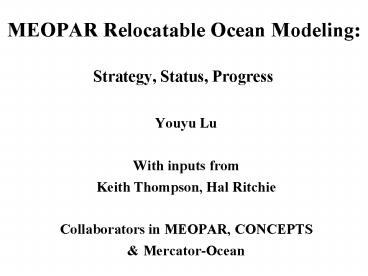MEOPAR Relocatable Ocean Modeling: Strategy, Status, Progress
Title:
MEOPAR Relocatable Ocean Modeling: Strategy, Status, Progress
Description:
Status: Existing NEMO Configurations Global: 1/4 for operational ocean & coupled weather-ocean forecasting 1 for coupled seasonal forecasting Regional: ... –
Number of Views:104
Avg rating:3.0/5.0
Title: MEOPAR Relocatable Ocean Modeling: Strategy, Status, Progress
1
MEOPAR Relocatable Ocean ModelingStrategy,
Status, Progress
- Youyu Lu
- With inputs from
- Keith Thompson, Hal Ritchie
- Collaborators in MEOPAR, CONCEPTS
- Mercator-Ocean
2
Goals of Relocatable Ocean Modelling
- A data assimilative coupled atmosphere-wave-ocean
forecast system that can be set-up within hours
of a marine emergency will be developed in order
to provide short-term forecasts (hours to days)
of the physical properties of the ocean and
atmosphere to help guide the response to the
emergency. The system will also include the
capacity to track plumes of hazardous materials
that can evolve based on the physical conditions.
Our research will focus on new capabilities
including (i) the ability to relocate the system
anywhere in Canadian waters within hours of an
emergency, and provide high resolution forecasts
of variables such as wind, sea fog, sea level,
waves and ocean currents (ii) the assimilation of
physical properties of the ocean and atmosphere
in order to improve the initial conditions and
thus the forecasts (iii) off-line modules for
tracking the movement of passive surface, and
subsurface plumes, that can take into account the
non- conservative properties of spilled materials
such as radioactive decay or degrading
hydrocarbons and the associated oxygen depletion,
and (iv) the explicit integration of knowledge
and modelling approaches related to biophysical
effects with those dealing with anticipated
socioeconomic vulnerabilities, risks and impacts.
3
Elements of a Relocatable Ocean Model
- Domain definition
- Grid creation
- Bathymetry
- Surface forcing
- Lateral boundary condition
- Code adjustment compile
- Model parameters
- Running, validation, analysis, product
4
Strategy
- Closely coordinate/collaborate with CONCEPTS
- Adopt CONCEPTS releases of NEMO code (1.1.0,
2.0.0 soon) - Assemble model preparation/analysis software
developed/cumulated over a decade through GOAPP,
CONCEPTS, etc. - Tests high-resolution regional models ( study)
- Automate software for relocatable capability
- Collaborate with Mercator-Ocean
- Collaborate within MEOPAR 1.1, 1.2 Prediction
Core, sharing resources
5
- Ocean Modelling Components in MEOPAR
Project 1.1 A Relocatable Coupled
Atmosphere-Ocean Prediction System Project 1.2
Building a Network of Fixed Coastal Observing and
Forecast Systems Project 2.1 Climate Change and
Extreme Events in the Marine Environment Project
2.2 Biogeochemical Projections Under a Changing
Climate Prediction Core Observation Core
6
Collaboration with Mercator-Ocean
- MERCATOR relocatable model
- Leader in region NEMO code development (e.g.,
OBC) - Java interface, high level automation
- Inflexibility grids only follow ORCA
- MEOPAR different complimentary aspects
- Flexible grids, bathymetry from Canadian sources
- Canadian atmosphere-Ocean forcing (GEM
CONCEPTS) - Lower level automation
- Co-development and sharing agreed
7
Status NEMO Team in CONCEPTS
- Model developers users
- F. Roy (code keeper), F. Dupont, Y. Lu, L. Zhai,
M. Casey - Data assimilation
- G. Smith, Y. Liu, Z. He
- Validation Product
- F. Davidson, S. Higginson, J. Xu
8
Status NEMO Applications in Canada
- CONCEPTS
- EC, DFO
- Academics
- Dalhousie, U Alberta, MUN, UQAR, U Manitoba,
UBC, - Climate Groups
- CCCma, UQAM,
9
Status Existing NEMO Configurations
- Global
- 1/4 for operational ocean coupled
weather-ocean forecasting - 1 for coupled seasonal forecasting
- Regional
- CREG (Arctic N Atlantic, plan to include N
Pacific) 1/12, 1/4 - Newfoundland shelf 1/36
- Gulf of St Lawrence, 5 km, plan 1 km
- Great Lakes, 2 km, plan 1 km
- Strait of Georgia, 0.5 km
10
Example Grid Generation
Relocatable capability applied to the Strait of
Georgia
Curvilinear grid definition using Seagrid
Grid definition using AGRIF
Create curvilinear grid using Seagrid
One out of 10 grid point is showed Grid size
898x398 Resolution 450m
Follow ORCA grid
AGRIF refinement - conserve the ORCA grid
orientation
11
Example Use of in situ Observed Bathymetry
Uncertainty in Hudson Bay/Strait
NABD
NABD ETOPO1
12
Diff in M2 magnitude
Improve M2 Tide Solution by Refining Bathymetry
CREG12 solution (T1)
13
Example High-Resolution Regional Modelling
- Newfound Shelf, 1/36 lat/lon (2.5 km), 50
vertical levels - Take initial and boundary conditions from
CREG12, GEM atmospheric forcing - Work started in April 2013 (L. Zhai)
- Solved a puzzle in setting lateral viscosity
- Stared validation analysis
- Animation of SSH
14
Progress Plan
- Prediction Core PDF, J-P Paquin, started may
2013 - Learned NEMO CONCEPTS v1.1.0
- Grid generation with Seagrid
- Improved documents for model preparation
- Created 0.5 km Strait of Georgia model and tested
simulation of tides - Package transferred to UBC
- Plan Automate software packages for relocatable
model development by PDF F. Chegini, expected to
start in early 2014.































